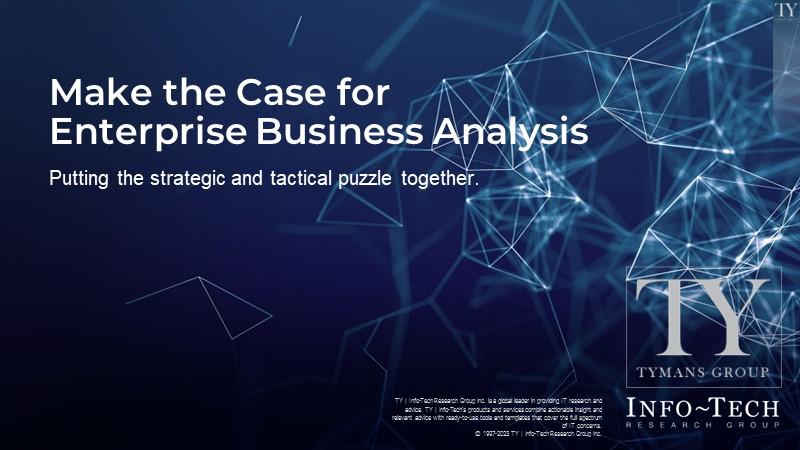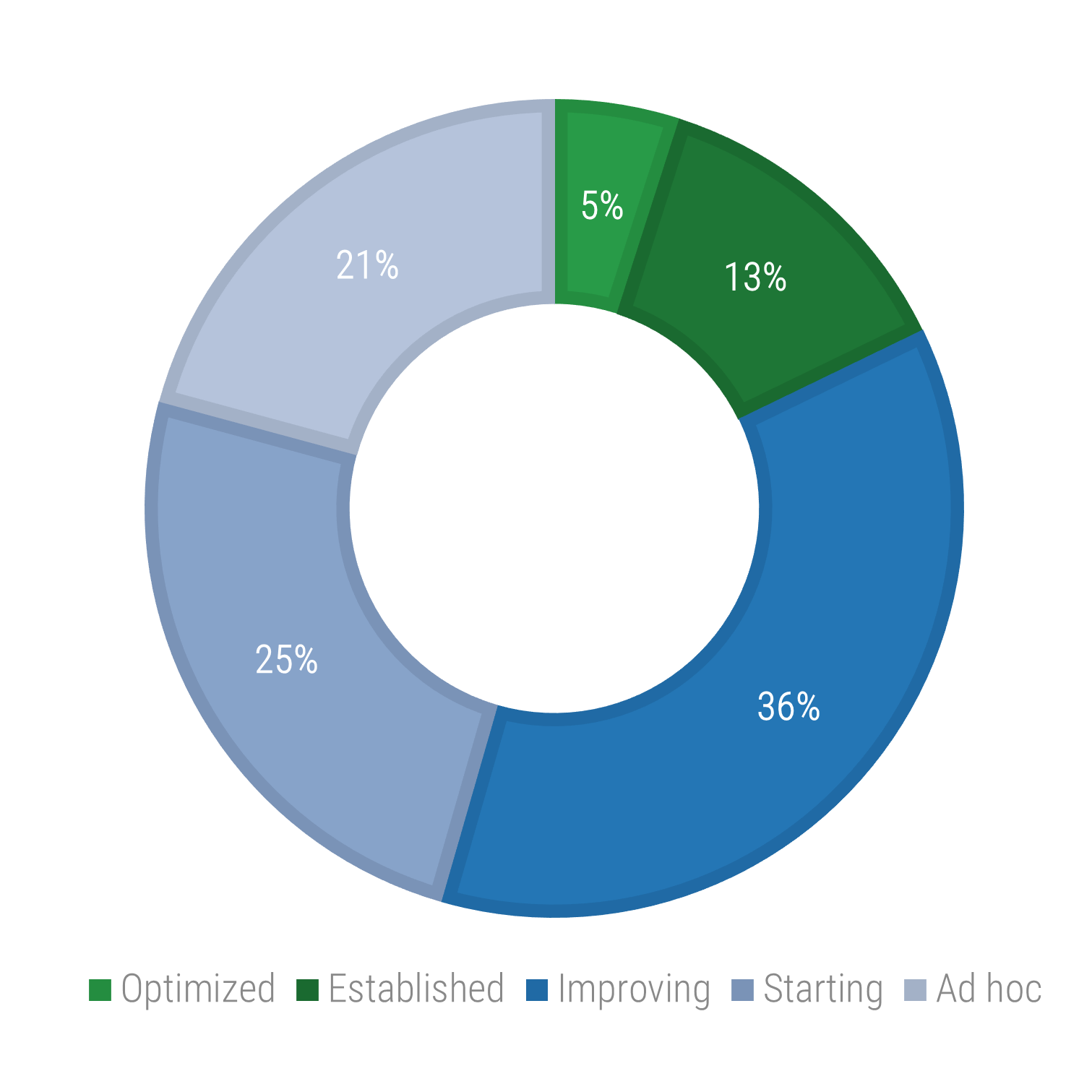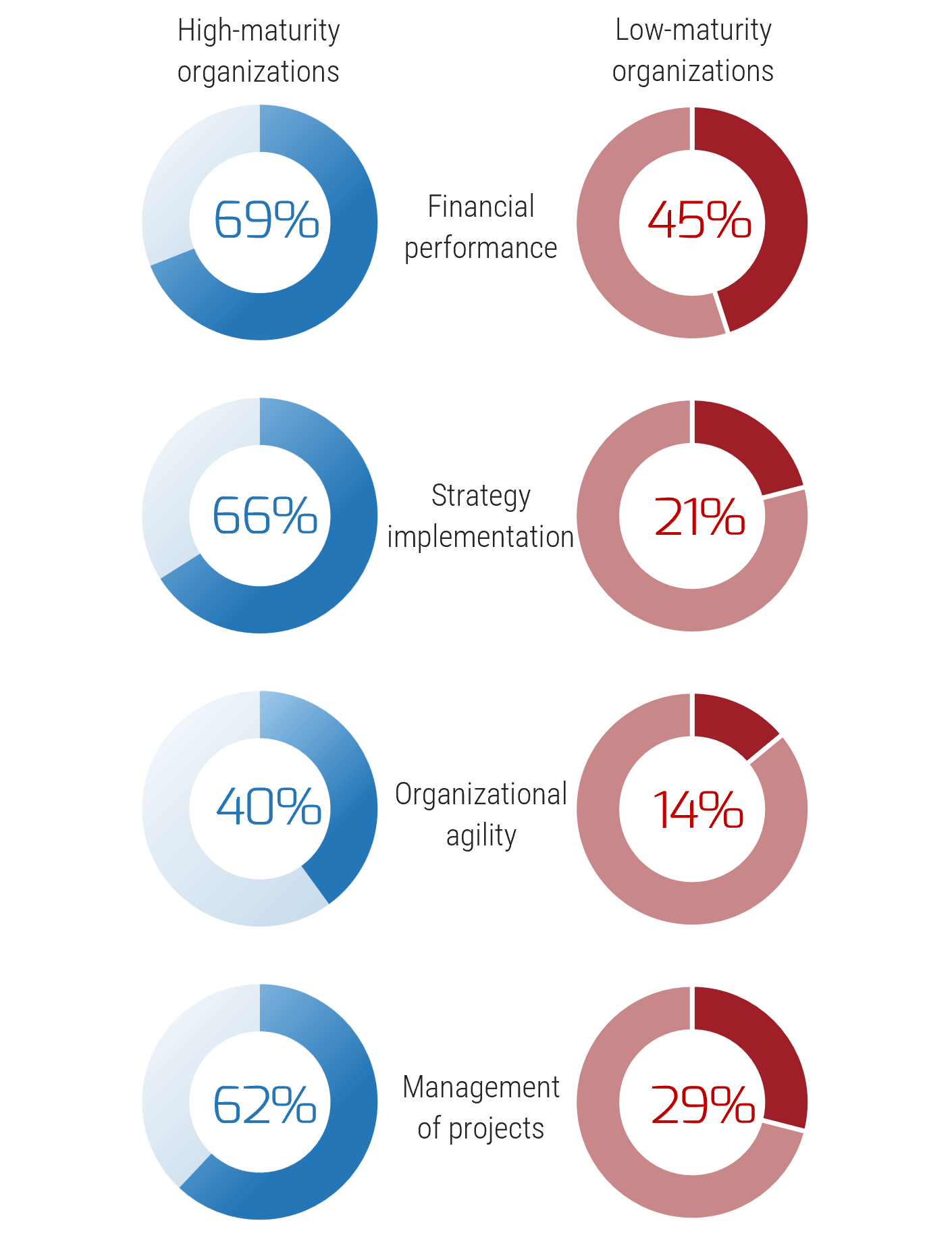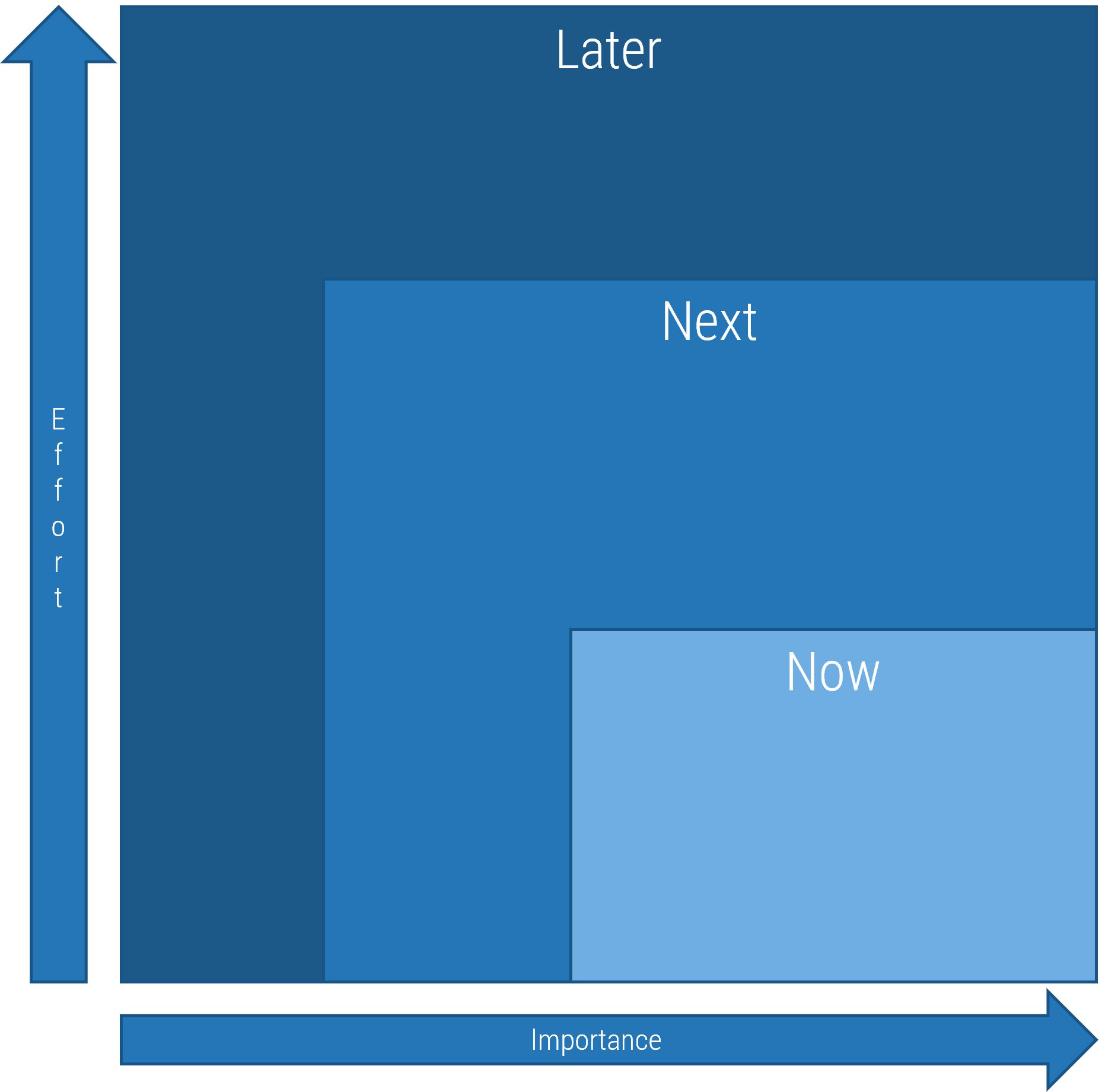
Make the Case for Enterprise Business Analysis
- It can be difficult to secure alignment between the many lines of business, IT included, in your organization.
- Historically, we have drawn a dividing line between IT and "the business.”
- The reality of organizational politics and stakeholder bias means that, with selection and prioritization, sometimes the highest value option is dismissed to make way for the loudest voice’s option.
Our Advice
Critical Insight
- Enterprise business analysis can help you stop the debate between IT and “the business,” as it sees everyone as part of the business. It can effectively break down silos, support the development of holistic strategies to address internal and external risks, and remove the bias and politics in decision making all too common in organizations.
- The business analyst is the only role that can connect the strategic with the tactical, the systems, and the operations and do so objectively. It is the one source to show how people, process, and technology connect and relate, and the most skilled can remove bias and politics from their lens of view.
- Maturity can’t be rushed. Build your enterprise business analysis program on a solid foundation of leading and consistent business analysis practices to secure buy-in and have a program that is sustainable in the long term.
Impact and Result
Let’s make the case for enterprise business analysis!
- Organizations that have higher business analysis maturity and deploy enterprise analysis deliver better quality outcomes, with higher value, lower cost, and higher user satisfaction.
- Business analysts should be contributing at the strategic level, as they need to understand multiple horizons simultaneously and be able to zoom in and out as the context calls for it. Business analysts aren’t only for projects.
Make the Case for Enterprise Business Analysis Research & Tools
Besides the small introduction, subscribers and consulting clients within this management domain have access to:
1. Make the Case for Enterprise Business Analysis Storyboard – Take your business analysis from tactics to strategy.
- Make the Case for Enterprise Business Analysis Storyboard
2. Communicate the Case for Enterprise Business Analysis Template – Make the case for enterprise business analysis.
- Communicate the Case for Enterprise Business Analysis
Further reading
Make the Case for Enterprise Business Analysis
Putting the strategic and tactical puzzle together.
Analyst Perspective
We commonly recognize the value of effective business analysis at a project or tactical level. A good business analysis professional can support the business by identifying its needs and recommending solutions to address them.
Now, wouldn't it be great if we could do the same thing at a higher level?
Enterprise (or strategic) business analysis is all about seeing that bigger picture, an approach that makes any business analysis professional a highly valuable contributor to their organization. It focuses on the enterprise, not a specific project or line of business.
Leading the business analysis effort at an enterprise level ensures that your business is not only doing things right, but also doing the right things; aligned with the strategic vision of your organization to improve the way decisions are made, options are analyzed, and successful results are realized.

Vincent Mirabelli
Principal Research Director, Applications Delivery and Management
Info-Tech Research Group
Executive Summary
Your Challenge
- Difficulty properly aligning between the many lines of business in your organization.
- Historically, we have drawn a dividing line between IT and the business.
- The reality of organizational politics and stakeholder bias means that, with selection and prioritization, sometimes the highest value option is dismissed in favor of the loudest voice.
Common Obstacles
- Difficulty aligning an ever-changing backlog of projects, products, and services while simultaneously managing risks, external threats, and stakeholder expectations.
- Many organizations have never heard of enterprise business analysis and only see the importance of business analysts at the project and delivery level.
- Business analysis professionals rarely do enough to advocate for a seat at the strategic tables in their organizations.
Info-Tech's Approach
Let's make the case for enterprise business analysis!
- Organizations that have higher business analysis maturity and deploy enterprise business analysis deliver better quality outcomes with higher value, lower cost, and higher user satisfaction.
- Business analysts aren't only for projects. They should contribute at the strategic level, since they need to understand multiple horizons simultaneously and be able to zoom in and out as the context requires.
Info-Tech Insight
Enterprise business analysis can help you reframe the debate between IT and the business, since it sees everyone as part of the business. It can effectively break down silos, support the development of holistic strategies to address internal and external risks, and remove bias and politics from decision making.
Phase 1
Build the case for enterprise business analysis
Phase 1 |
Phase 2 |
|---|---|
1.1 Define enterprise business analysis 1.2 Identify your pains and opportunities |
2.1 Set your vision 2.2 Define your roadmap and next steps 2.3 Complete your executive communications deck |
This phase will walk you through the following activities:
- 1.1.1 Discuss how business analysis is used in our organization
- 1.1.2 Discuss your disconnects between strategy and tactics
- 1.2.1 Identify your pains and opportunities
This phase involves the following participants:
- Business analyst(s)
- Organizational business leaders
- Any other relevant stakeholders
How business analysis supports our success today
Delivering value at the tactical level
Effective business analysis helps guide an organization through improvements to processes, products, and services. Business analysts "straddle the line between IT and the business to help bridge the gap and improve efficiency" in an organization (CIO, 2019).
They are most heavily involved in:
- Defining needs
- Modeling concepts, processes, and solutions
- Conducting analysis
- Maintaining and managing requirements
- Managing stakeholders
- Monitoring progress
- Doing business analysis planning
- Conducting elicitation
In a survey, business analysts indicated that of their total working time, they spend 31% performing business analysis planning and 41% performing elicitation and analysis (PMI, 2017).
By including a business analyst in a project, organizations benefit by:
(IAG, 2009)
87% |
Reduced time overspending |
|---|---|
75% |
Prevented budget overspending |
78% |
Reduction in missed functionality |
1.1.1 Discuss how business analysis is used in your organization
15-30 minutes
- Gather the appropriate stakeholders to discuss their knowledge, experience, and perspectives on business analysis. This should relate to their experience and not a future or aspirational usage.
- Have a team member facilitate the session.
- Brainstorm and document all shared thoughts and perspectives.
- Synthesize those thoughts and perspectives and record the results for the group to review and discuss.
- Transfer the results to the Communicate the Case for Enterprise Business Analysis template
Input
- Stakeholder knowledge and experience
Output
- A shared understanding of how your organization leverages its business analysis function
Materials
- Whiteboard/Flip charts
- Collaborative whiteboard
- Communicate the Case for Enterprise Business Analysis template
Participants
- Business analyst(s)
- Organizational business leaders
- Any other relevant stakeholders
Download the Communicate the Case for Enterprise Business Analysis template
Executives and leadership are satisfied with IT when there is alignment between tactics and goals
Info-Tech's CIO Business Vision Survey data highlights the importance of IT projects in supporting the business to achieve its strategic goals.
However, Info-Tech's CEO-CIO Alignment Survey (N=124) data indicates that CEOs perceive IT as poorly aligned with the business' strategic goals.
Info-Tech's CIO-CEO Alignment Diagnostics
43% |
of CEOs believe that business goals are going unsupported by IT. |
|---|---|
60% |
of CEOs believe that IT must improve understanding of business goals. |
80% |
of CIOs/CEOs are misaligned on the target role of IT. |
30% |
of business stakeholders support their IT departments. |
Addressing problems solely with tactics does not always have the desired effect
94%
Source: "Out of the Crisis", Deming (via Harvard Business Review)
According to famed management and quality thought leader and pioneer W. Edwards Deming, 94% of issues in the workplace are systemic cause significant organizational pain.
Yet we continue to address them on the surface, rather than acknowledge how ingrained they are in our culture, systems, and processes.
For example, we:
- Create workarounds to address process and solution constraints
- Expect that poor (or lack of ) leadership can be addressed in a course or seminar
- Expect that "going Agile" will resolve our problems, and that decision making, governance, and organizational alignment will happen organically.
Band-aid solutions rarely have the desired effect, particularly in the long-term.
Our solutions should likewise focus on the systemic/macro environment. We can do this via projects, products and services, but those don't always address the larger issues.
If we take the work our business analysis currently does in defining needs and solutions, and elevate this to the strategic level, the results can be impactful.
Many organizations would benefit from enhancing their business analysis maturity
The often-overlooked strategic value of the role comes with maturing your practices.
Only 18% of organizations have mature (optimized or established) business analysis practices.
With that higher level of maturity comes increased levels of capability, efficiency, and effectiveness in delivering value to people, processes, and technology. Through such efforts, they're better equipped and able to connect the strategy of their organization to the projects, processes, and products they deliver.
They shift focus from "figuring business analysis out" to truly unleashing its potential, with business analysts contributing in strategic and tactical ways.

(Adapted from PMI, 2017)
Info-Tech Insight
Business analysts are best suited to connect the strategic with the tactical, the systems, and the operations. They maintain the most objective lens regarding how people, process, and technology connect and relate, and the most skilled of them can remove bias and politics from their perspective.
1.1.2 Discuss your disconnects between strategy and tactics
30-60 minutes
- Gather the appropriate stakeholders to discuss their knowledge, experience, and perspectives regarding failures that resulted from disconnects between strategy and tactics.
- Have a team member facilitate the session.
- Brainstorm and document all shared thoughts and perspectives.
- Synthesize those thoughts and perspectives and record the results.
- Transfer the results to the Communicate the Case for Enterprise Business Analysis template.
Input
- Stakeholder knowledge and experience
Output
- A shared understanding and list of failures due to disconnects between strategy and tactics
Materials
- Whiteboard/Flip charts
- Collaborative whiteboard
- Communicate the Case for Enterprise Business Analysis template
Participants
- Business analyst(s)
- Organizational business leaders
- Any other relevant stakeholders
Download the Communicate the Case for Enterprise Business Analysis template
Defining enterprise business analysis
Terms may change, but the function remains the same.
Enterprise business analysis (sometimes referred to as strategy analysis) "…focuses on defining the future and transition states needed to address the business need, and the work required is defined both by that need and the scope of the solution space. It covers strategic thinking in business analysis, as well as the discovery or imagining of possible solutions that will enable the enterprise to create greater value for stakeholders and/or capture more value for itself."
(Source: "Business Analysis Body of Knowledge," v3)
Define the function of enterprise business analysis
This is a competitive advantage for mature organizations.
Organizations with high-performing business analysis programs experience an enhanced alignment between strategy and operations. This contributes to improved organizational performance. We see this in financial (69% vs. 45%) and strategic performance (66% vs. 21%), also organizational agility (40% vs. 14%) and management of operational projects (62% vs. 29%). (PMI, 2017)
When comparing enterprise with traditional business analysis, we see stark differences in the size and scope of their view, where they operate, and the role they play in organizational decision making.
| Enterprise | Traditional | |
|---|---|---|
| Decision making | Guides and influences | Executes |
| Time horizon | 2-10 years | 0-2 years |
| Focus | Strategy, connecting the strategic to the operational | Operational, optimizing how business is done, and keeping the lights on |
| Domain | Whole organization Broader marketplace |
Only stakeholder lines of business relevant to the current project, product or service |
| Organizational Level | Executive/Leadership | Project |
(Adapted from Schulich School of Business)
Info-Tech Insight
Maturity can't be rushed. Build your enterprise business analysis program on a solid foundation of leading and consistent business analysis practices to secure buy-in and have a program that is sustainable in the long term.

(Adapted from PMI, 2017)
How enterprise business analysis is used to improve organizations
The biggest sources of project failure include:
- Wrong (or poor) requirements
- Unrealistic (or incomplete) business case
- Lack of appropriate governance and oversight
- Poor implementation
- Poor benefits management
- Environmental changes
Source: MindTools.com, 2023.
Enterprise business analysis addresses these sources and more.
It brings a holistic view of the organization, improving collaboration and decision making across the many lines of business, effectively breaking down silos.
In addition to ensuring we're doing the right things, not just doing things right in the form of improved requirements and more accurate business cases, or ensuring return on investment (ROI) and monitoring the broader landscape, enterprise business analysis also supports:
- Reduced rework and waste
- Understanding and improving operations
- Making well-informed decisions through improved objectivity/reduced bias
- Identifying new opportunities for growth and expansion
- Identifying and mitigating risk
- Eliminating projects and initiatives that do not support organizational goals or objectives
- A career-pathing option for business analysts
Identify your pains and opportunities
There are many considerations in enterprise business analysis.
Pains, gains, threats, and opportunities can come at your organization from anywhere. Be it a new product launch, an international expansion, or a new competitor, it can be challenging to keep up.
This is where an enterprise business analyst can be the most helpful.
By keeping a pulse on the external and internal environments, they can support growth, manage risks, and view your organization through multiple lenses and perspectives to get a single, complete picture.
External |
Internal |
|
|---|---|---|
Identifying competitive forces |
In the global environment |
Organizational strengths and weaknesses |
|
|
|
1.2.1 Identify your pains and opportunities
30-60 minutes
- As a group, generate a list of the current pains and opportunities facing your organization. You can focus on a particular type (competitive, market, or internal) or leave it open. You can also focus on pains or opportunities separately, or simultaneously.
- Have a team member facilitate the session.
- Record the results for the group to review, discuss, and prioritize.
- Discuss the impact and likelihood of each item. This can be formally ranked and quantified if there is data to support the item or leveraging the wisdom of the group.
- Prioritize the top three to five items of each type, as agreed by the group, and document the results.
- Transfer the results to the Communicate the Case for Enterprise Business Analysis template.
Download the Communicate the Case for Enterprise Business Analysis template
Input
- Attendee knowledge
- Supporting data, if available
Output
- A list of identified organizational pains and opportunities that has been prioritized by the group
Materials
- Whiteboard/Flip charts
- Collaborative whiteboard
- Communicate the Case for Enterprise Business Analysis template
Participants
- Business analyst(s)
- Organizational business leaders
- Any other relevant stakeholders
Phase 2
Prepare the foundations for your enterprise business analysis program
Phase 1 | Phase 2 |
|---|---|
1.1 Define enterprise business analysis 1.2 Identify your pains and opportunities | 2.1 Set your vision 2.2 Define your roadmap and next steps 2.3 Complete your executive communications deck |
This phase will walk you through the following activities:
- 2.1.1 Define your vision and goals
- 2.1.2 Identify your enterprise business analysis inventory
- 2.2.1 Now, Next, Later
This phase involves the following participants:
- Business analyst(s)
- Organizational business leaders
- Any other relevant stakeholders
Set your vision
Your vision becomes your "north star," guiding your journey and decisions.
When thinking about a vision statement for enterprise business analysis, think about:
- Who are we doing this for? Who will benefit?
- What do our business partners need? What do our customers need?
- What value do we provide them? How can we best support them?
- Why is this special/different from how we usually do business?
Always remember: Your goal is not your vision!
Not knowing the difference will prevent you from both dreaming big and achieving your dream.
Your vision represents where you want to go. It's what you want to do.
Your goals represent how you want to achieve your vision.
- They are a key element of operationalizing your vision.
- Your strategy, initiatives, and features will align with one or more goals.
Info-Tech Best Practice
Your vision shouldn't be so far out that it doesn't feel real, nor so short term that it gets bogged down in details. Finding balance will take some trial and error and will be different depending on your organization.
2.1.1 Define your vision and goals
1-2 hours
- Gather the appropriate stakeholders to discuss their vision for enterprise business analysis. It should address the questions used in framing your vision statement.
- Have a team member facilitate the session.
- Review your current organizational vision and goals.
- Discuss and document all shared thoughts and perspectives on how enterprise business analysis can align with the organizational vision.
- Synthesize those thoughts and perspectives to create a vision statement.
- Transfer the results to the Communicate the Case for Enterprise Business Analysis template.
Download the Communicate the Case for Enterprise Business Analysis template
Input
- Stakeholder vision, knowledge, and experience
- Current organizational vision and goals
Output
- A documented vision and goals for your enterprise business analysis program
Materials
- Whiteboard/Flip charts
- Collaborative whiteboard
- Communicate the Case for Enterprise Business Analysis template
Participants
- Business analyst(s)
- Organizational business leaders
- Any other relevant stakeholders
Components of successful enterprise business analysis programs
Ensure you're off to the best start by examining where you are and where you want to go.
Training
- Do the current team members have the right level of training?
- Can we easily obtain training to close any gaps?
Competencies and capabilities
- Do our business analysts have the right skills, attributes, and behaviors to be successful?
Structure and alignment
- Would the organizational culture support enterprise business analysis (EBA)?
- How might we structure the EBA unit to maximize effectiveness?
- How can we best support the organization's goals and objectives?
Methods and processes
- How do we plan on managing the work to be done?
- Can we define our processes and workflows?
Tools, techniques, and templates
- Do we have the most effective tools, techniques, and templates?
Governance
- How will we make decisions?
- How will the program be managed?
2.1.2 Identify your enterprise business analysis inventory
30-60 minutes
- Gather the appropriate stakeholders to discuss the current business analysis assets, which could be leveraged for enterprise business analysis. This includes people, processes, and technologies which cover skills, knowledge, resources, experience, knowledge, and competencies. Focus on what the organization currently has, and not what it needs.
- Have a team member facilitate the session.
- Record the results for the group to review and discuss.
- Transfer the results to the Communicate the Case for Enterprise Business Analysis template.
Download the Communicate the Case for Enterprise Business Analysis template
Input
- Your current business analysis assets and resources Stakeholder knowledge and experience
Output
- A list of assets and resources to enable enterprise business analysis
Materials
- Whiteboard/Flip charts
- Collaborative whiteboard
- Communicate the Case for Enterprise Business Analysis template
Participants
- Business analyst(s)
- Organizational business leaders
- Any other relevant stakeholders
Define your roadmap and next steps
What do we have? What do we need?
From completing the enterprise business analysis inventory, you will have a comprehensive list of all available assets.
The next question is, how can this be leveraged to start building for the future?
To operationalize enterprise business analysis, consider:
- What do we still need to do?
- How important are the identified gaps? Can we still operate?
- What decisions do we need to make?
- What stakeholders do we need to involve? Have we engaged them all?
Lay out your roadmap
Taking steps to mature your enterprise business analysis practice.
The Now, Next, Later technique is a method for prioritizing and planning improvements or tasks. This involves breaking down a list of tasks or improvements into three categories:
- Now tasks are those that must be completed immediately. These tasks are usually urgent or critical, and they must be completed to keep the project or organization running smoothly.
- Next tasks are those that should be completed soon. These tasks are not as critical as Now tasks, but they are still important and should be tackled relatively soon.
- Later tasks are those that can be completed later. These tasks are less critical and can be deferred without causing major problems.
By using this technique, you can prioritize and plan the most important tasks, while allowing the flexibility to adjust as necessary.
This technique also helps clarify what must be done first vs. what can wait. This prioritizes the most important things while keeping track of what must be done next, maintaining a smooth development/improvement process.

2.2.1 Now, Next, Later
1-2 hours
- Use the list of items created in 2.1.2 (Identify your enterprise business analysis inventory). Add any you feel are missing during this exercise.
- Have a team member facilitate the session.
- In the Communicate the Case for Enterprise Business Analysis template, categorize these items according to Now, Next and Later, where:
- Now = Critically important items that may require little effort to complete. These must be done within the next six months.
- Next = Important items that may require more effort or depend on other factors. These must be done in six to twelve months.
- Later = Less important items that may require significant effort to complete. These must be done at some point within twelve months.
Ultimately, the choice of priority and timing is yours. Recognize that items may change categories as new information arises.
Download the Communicate the Case for Enterprise Business Analysis template
Input
- Your enterprise business analysis inventory and gaps
- Stakeholder knowledge and experience
Output
- A prioritized list of items to enable enterprise business analysis
Materials
- Whiteboard/Flip charts
- Collaborative whiteboard
- Communicate the Case for Enterprise Business Analysis template
Participants
- Business analyst(s)
- Organizational business leaders
- Any other relevant stakeholders
2.3 Complete your executive communication deck
Use the results of your completed exercises to build your executive communication slide deck, to make the case for enterprise business analysis
| Slide Header | Associated Exercise | Rationale |
|---|---|---|
| Pains and opportunities | 1.1.2 Discuss your disconnects between strategy and tactics 1.2.1 Identify your pains and opportunities |
This helps build the case for enterprise business analysis (EBA), leveraging the existing pains felt in the organization. This will draw the connection for your stakeholders. |
| Our vision and goals | 2.1.1 Define your vision and goals | Defines where you want to go and what effort will be required. |
| What is enterprise business analysis | 1.1.1 How is BA being used in our organization today? |
Defines the discipline of EBA and how it can support and mature your organization. |
| Expected benefits | Pre-populated supporting content | What's in it for us? This section helps answer that question. What benefits can we expect, and is this worth the investment of time and effort? |
| Making this a reality | 2.1.2 Identify your EBA inventory | Identifies what the organization presently has that makes the effort easier. It doesn't feel as daunting if there are existing people, processes, and technologies in place and in use today. |
| Next steps | 2.2.1 Now, Next, Later | A prioritized list of action items. This will demonstrate the work involved, but broken down over time, into smaller, more manageable pieces. |
Track metrics
Track metrics throughout the project to keep stakeholders informed.
As the project nears completion:
- You will have better-aligned and more satisfied stakeholders.
- You will see fewer projects and initiatives that don't align with the organizational goals and objectives.
- There will be a reduction in costs attributed to misaligned projects and initiatives (as mentioned in #2) and the opportunity to allocate valuable time and resources to other, higher-value work.
| Metric | Description | Target Improvement/Reduction |
|---|---|---|
| Improved stakeholder satisfaction | Lines of business and previously siloed departments/divisions will be more satisfied with time spent on solution involvement and outcomes. | 10% year 1, 20% year 2 |
| Reduction in misaligned/non-priority project work | Reduction in projects, products, and services with no clear alignment to organizational goals. With that, resource costs can be allocated to other, higher-value solutions. | 10% year 1, 25% year 2 |
| Improved delivery agility/lead time | With improved alignment comes reduced conflict and political infighting. As a result, the velocity of solution delivery will increase. | 10% |
Bibliography
Bossert, Oliver and Björn Münstermann. "Business's 'It's not my problem' IT problem." McKinsey Digital. 30 March, 2023.
Brule, Glenn R. "The Lay of the Land: Enterprise Analysis." Modern Analyst.
"Business Analysis: Leading Organizations to Better Outcomes." Project Management Institute (PMI), 2017
Corporate Finance Institute. "Strategic Analysis." Updated 14 March 2023
IAG Consulting. Business Analysis Benchmark Report, 2009.
International Institute of Business Analysis. "A Guide to the Business Analysis Body of Knowledge" (BABOK Guide) version 3.
Mirabelli, Vincent. "Business Analysis Foundations: Enterprise" LinkedIn Learning, February 2022.
- - "Essential Techniques in Enterprise Analysis" LinkedIn Learning, September 2022.
- - "The Essentials of Enterprise Analysis" Love the Process Academy. May 2020.
- - "The Value of Enterprise Analysis." VincentMirabelli.com
Praslova, Ludmila N. "Today's Most Critical Workplace Challenges Are About Systems." Harvard Business Review. 10 January 2023.
Pratt, Mary K. and Sarah K. White. "What is a business analyst? A key role for business-IT efficiency." CIO. 17 April, 2019.
Project Management Institute. "Business Analysis: Leading Organizations to Better Outcomes." October 2017.
Sali, Sema. "The Importance of Strategic Business Analysis in Successful Project Outcomes." International Institute of Business Analysis. 26 May 2022.
- - "What Does Enterprise Analysis Look Like? Objectives and Key Results." International Institute of Business Analysis. 02 June 2022.
Shaker, Kareem. "Why do projects really fail?" Project Management Institute, PM Network. July 2010.
"Strategic Analysis: Definition, Types and Benefits" Voxco. 25 February 2022.
"The Difference Between Enterprise Analysis and Business Analysis." Schulich School of Business, Executive Education Center. 24 September 2018 (Updated June 2022)
"Why Do Projects Fail: Learning How to Avoid Project Failure." MindTools.com. Accessed 24 April 2023.